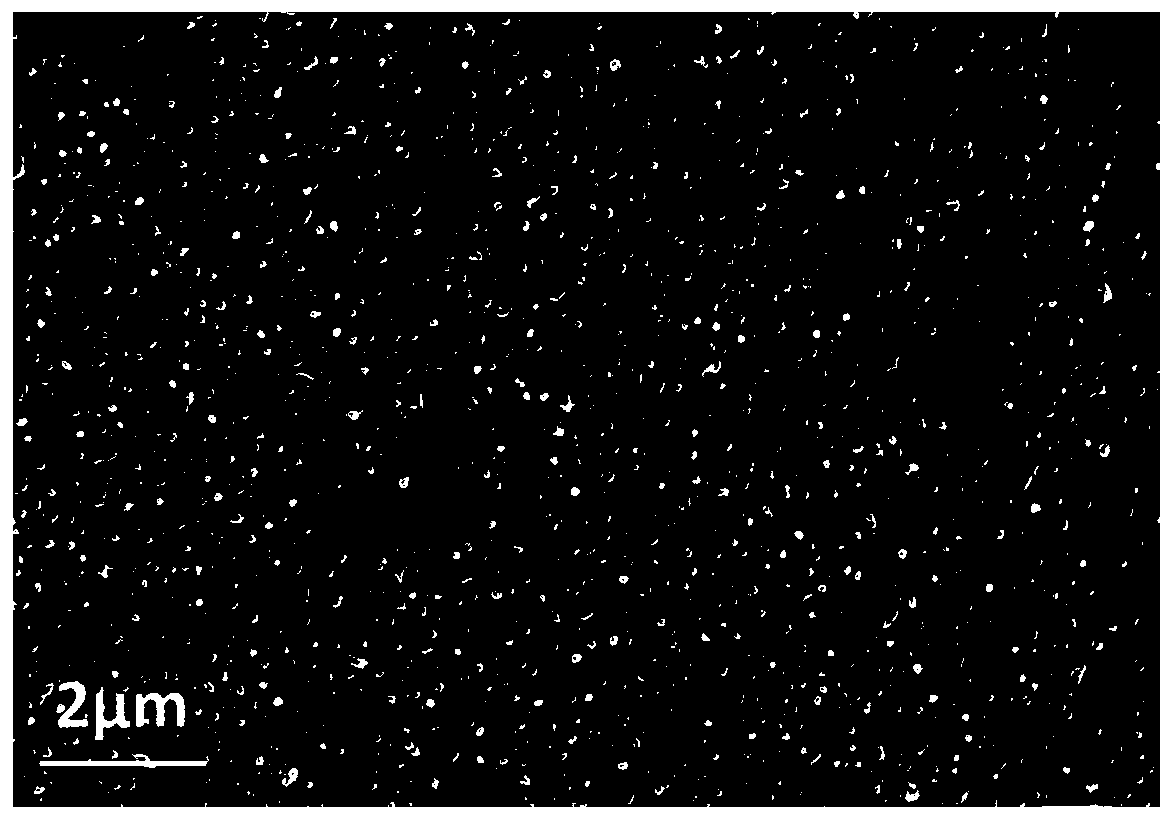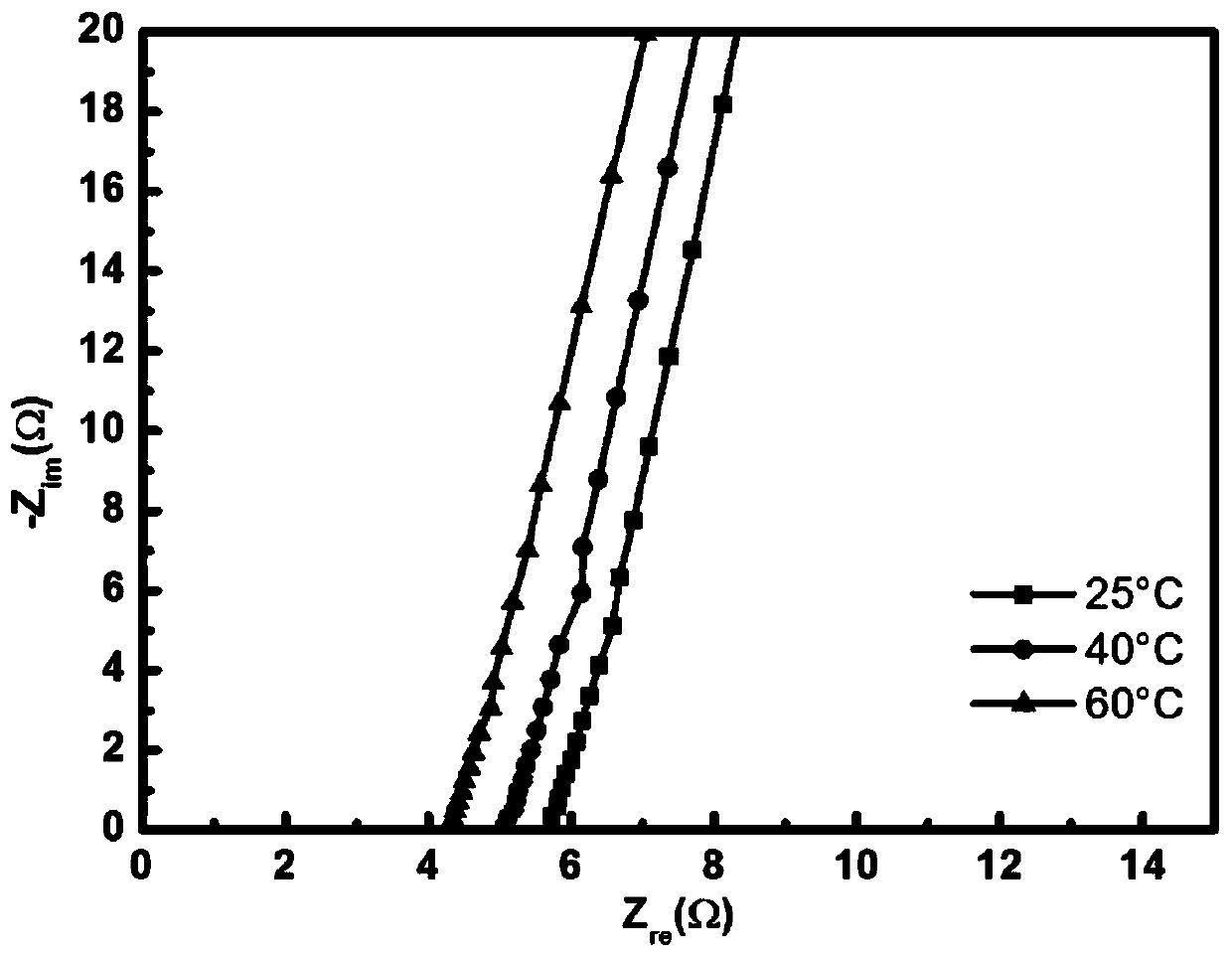Flexible solid-state lithium ion conductor applied to battery and preparation method thereof
An ionic conductor and solid lithium technology, applied in battery electrodes, secondary batteries, circuits, etc., can solve problems such as low conductivity, achieve the effect of improving exercise ability and ensuring transmission ability
- Summary
- Abstract
- Description
- Claims
- Application Information
AI Technical Summary
Problems solved by technology
Method used
Image
Examples
Embodiment 1
[0026] (1) The polymer is grafted polyvinyl formal with lithium monooxalate borate, and the structural formula is as follows, where x:y = 4. Weigh 0.4305 g of the above polymer and dissolve it in 2.583 g of dimethyl sulfoxide, stir well to completely dissolve it.
[0027]
[0028](2) Continue to add 0.031g of boron-containing organolithium salt LiODFB (relative molecular weight 144), corresponding to the general structure R 1 The molar ratio of (1,3-dioxane) to lithium ions of the organolithium salt LiODFB was 15:1 to form a solution.
[0029] (3) Then the solution was heated to 70°C and stirred for 24 hours to obtain a slurry, which was then uniformly coated on a glass plate and dried in vacuum at 50°C for 24 hours to obtain a flexible solid lithium ion conductor.
[0030] The microscopic appearance of the flexible solid-state lithium ion conductor obtained in Example 1 is as follows: figure 1 As shown, it can be seen from the figure that the lithium ion conductor is a d...
Embodiment 2
[0038] (1) The polymer is grafted polyvinylidene fluoride with lithium benzenesulfonate, and the structural formula is as follows, where x: y= 1.2:1. Take 0.7231 g of the above polymer and dissolve it in 3.32 g of acetonitrile, stir well to make it dissolve completely.
[0039]
[0040] (2) Continue to add 0.054g of organic lithium salt LiBETI (relative molecular weight 387) with sulfonimide group, corresponding to the general structure R 1 The (-CH 2 -CF 2 -) with the organolithium salt LiBETI lithium ions in a molar ratio of 50:1 to form a solution.
[0041] (3) Then the solution was heated to 40° C. and stirred for 30 h to obtain a slurry. Finally, the slurry was vacuum-dried at 60 °C for 36 h to obtain a flexible solid-state Li-ion conductor.
[0042] The AC impedance test result of the flexible solid-state lithium ion conductor obtained in embodiment 2 is as follows image 3 As shown, at a room temperature of 25 °C, the room temperature conductivity of the lithium...
Embodiment 3
[0049] (1) The polymer is grafted polyethylene carbonate with perfluoroalkylcarboxylithium, and the structural formula is as follows, where x:y =2.4:1. Weigh 0.6471 g of the above polymer and dissolve it in 2.983 g of tetrahydrofuran, stir well to completely dissolve it.
[0050]
[0051] (2) Continue to add 0.151g organolithium salt ddCTP-Li containing phosphoric acid group 3 (relative molecular mass 469), corresponding to the general structure R 1 of (-O-CO-O-CH 2 -) with organolithium salt ddCTP-Li 3 The molar ratio of lithium ions is 10:1, forming a solution.
[0052] (3) Then the solution was heated to 120 °C and stirred for 2 h to obtain a slurry, which was evenly coated on a glass plate, and finally vacuum-dried at 60 °C for 36 h to obtain a flexible solid lithium ion conductor.
[0053] The obtained solid lithium ion conductor of embodiment 3 has good flexibility; Tensile strength-strain curve is as follows Figure 7 As shown, its mechanical strength is as high...
PUM
| Property | Measurement | Unit |
|---|---|---|
| electrical conductivity | aaaaa | aaaaa |
| electrical conductivity | aaaaa | aaaaa |
| electrical conductivity | aaaaa | aaaaa |
Abstract
Description
Claims
Application Information
 Login to View More
Login to View More - R&D
- Intellectual Property
- Life Sciences
- Materials
- Tech Scout
- Unparalleled Data Quality
- Higher Quality Content
- 60% Fewer Hallucinations
Browse by: Latest US Patents, China's latest patents, Technical Efficacy Thesaurus, Application Domain, Technology Topic, Popular Technical Reports.
© 2025 PatSnap. All rights reserved.Legal|Privacy policy|Modern Slavery Act Transparency Statement|Sitemap|About US| Contact US: help@patsnap.com



